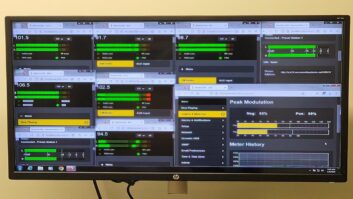Most State Emergency Communications Committees (SECCs) have submitted their state EAS plans to the FCC prior to the agency’s July 5 deadline. Alabama is no exception.
Larry Wilkins is the director of engineering services for the Alabama Broadcasters Association and chairman of the state’s SECC. He shared with Radio World the improvements that were made to Alabama’s EAS plan, which, according to ABA’s website, was drafted in 2017 and last revised in January 2021. He also spoke to the systems Alabama already has in place in case of state emergencies.

Radio World: Who constitutes the membership of your SECC?
Larry Wilkins: The Alabama SECC is made up of representatives from all agencies/organizations that are responsible for the distribution of state EAS alerts and tests.
This includes the State Emergency Management Agency (AEMA); Alabama Law Enforcement Agency (ALEA); National Weather Service (NWS); Alabama Broadcasters Association (ABA); Alabama Cable Association (ACA); Technical representatives from radio and television operations in the state.
RW: What steps did your SECC take, if any, as a result of the FCC’s recent actions to improve EAS?
Wilkins: The SECC met to discuss any changes needed before filling out the new online version of the plan. We did make some minor adjustments in the monitoring assignments to state relay networks and LP stations to ensure national level alerts issued via the state PEP station are relayed with the shortest route possible.
[Related: “Not All SECCs Have Submitted State EAS Plans“]
RW: How is the state plan that you’ve submitted different from your earlier plans?
Wilkins: The paper version of the Alabama State EAS plan had a lot more information than was requested by the online version. Looking back, there was probably too much information concerning technical operation of the EAS system in the original plan. I feel the new form is a good idea, since it allows FEMA and the commission to have the same form for all states.
RW: What special considerations does EAS have to deal with in Alabama?
Wilkins: Alabama, being a costal state, which borders the Gulf of Mexico is subject to hurricanes quite often, plus the state has two nuclear power plants in operation. EAS participants (in affected areas) are instructed to program their EAS units for these two possibilities.
RW: What unusual alert systems or infrastructure is in place that other states might find interesting?
Wilkins: The Alabama PEP station is an AM station that operates with 50 kW day and 500 watts at night. We have installed an IP feed from the PEP station to the master control of our two state relay networks, Alabama Public Television Network and Alabama Public Radio Network.
[Related: “Wyoming Overhauls SECC to Draft State EAS Plan“]
RW: What else should we know?
Wilkins: The Alabama SECC maintains a special EAS monitor server that presently is monitoring over 170 different EAS units around the state. This server was installed several years ago to enable the SECC to keep a watch on the “health” of the state EAS distribution system. This as proven to be beneficial in spotting and correcting any issues around the state. There are no cost to the stations for this service. Stations are reminded that the state server does not relieve them from maintaining the required Station Log.
The Alabama SECC also has a satellite network (GSSNet) that allows approved agencies to issue statewide alerts through a secure portal. We presently have 44 downlinks at major stations around the state. This system was installed and maintained without any cost to the station. It is interconnected with the IPAWS system and serves a redundant distribution system in the state.
RW: Can you provide a link to your plan, or a graphic from the plan as a visual?
Wilkins: The Alabama SECC filed the plan in May. It was reviewed by the commission and, following a conference call, we made some edits to the plan and resubmitted it for review. We understand the online plan is not available for viewing by anyone other than the FCC and FEMA.
Our present plan is posted on the Alabama Broadcasters Association website. We are working on an updated EAS monitor assignment document that will be on the ABA website as well.











